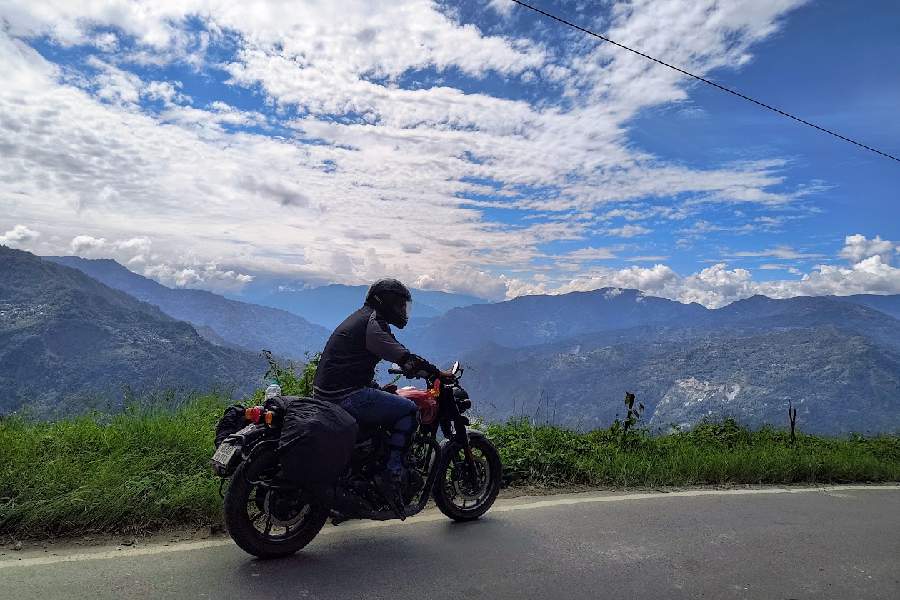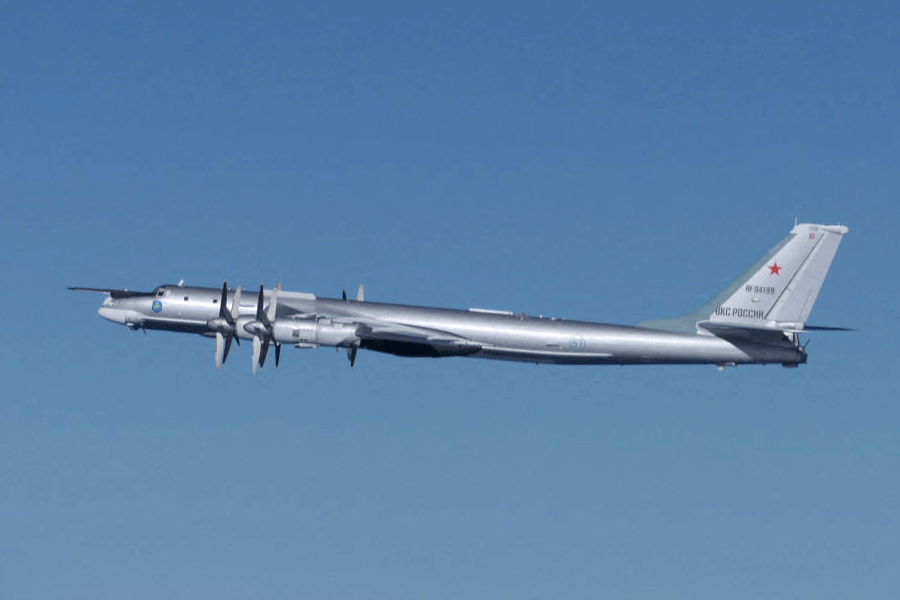The first part of this feature detailed the author's demanding motorbike pilgrimage to Sikkim, immediately challenged by torrential rain and landslides that closed National Highway 10. Forced to take a long, 120km detour, the couple battles terrifying, near-zero visibility fog while climbing through the mountains toward Lava. Their perseverance is rewarded the next morning with a crystalline-clear view of the sacred, snow-covered Kanchenjunga. They then navigate the landslide-ravaged highway and successfully reach the capital, Gangtok, concluding Part One with a liberating evening exploring the city's pedestrian heart, MG Marg.
To the roof of the world
The next morning dawned clear, a gift from weather gods who'd apparently decided to give us a break. Today's journey would take us to Tsomgo Lake, Nathula Pass, and the recently reopened Doklam and Cho La Pass areas. The territories had been sealed for five years following the 2017 India-China military standoff, when soldiers from both nations faced off in a tense, months-long confrontation that brought two nuclear powers to the brink.
We'd obtained the necessary permits the previous day. Travel to these sensitive border areas requires government authorisation, strictly monitored by the Indian Army. We departed at 8am, beginning the serpentine ascent into terrain where oxygen grows thin and the air itself feels sharper, cleaner, almost crystalline.
The BRO's engineering prowess revealed itself in these roads, which carved through impossible terrain with the precision of a surgical incision. Switchback after switchback, we climbed higher, the landscape transforming from temperate forest to alpine meadows to something approaching lunar desolation.
The roads were smooth as butter — a minor miracle considering they exist at altitudes where winter snow buries them for months and summer monsoons try to wash them away.
Nathula Pass sits at 14,140 feet, one of the highest motorable roads in the world and a functioning border crossing between India and China. The pass remains open for border trade four days a week, when Indian and Chinese traders exchange goods through a system of controlled handovers.
When we arrived, the wind was fierce enough to make standing upright difficult. Chinese observation posts were clearly visible on the opposite ridgeline, and Indian Army bunkers dotted our side, a reminder that this beautiful, barren landscape is also a military chessboard where two civilisations meet with mutual suspicion.
From Nathula, we visited the Baba Harbhajan Singh Memorial — both the old and new shrines dedicated to an Indian Army soldier whose legend has achieved almost mythical status.
According to widespread belief among soldiers stationed here, Baba Harbhajan Singh died in 1968 while escorting a mule caravan when he fell into a fast-flowing stream. After his death, he allegedly appeared to fellow soldiers in dreams, asking them to build a shrine at the spot where he died.
The shrine is now maintained by the army, and soldiers swear that Baba's spirit still patrols these heights, watching over Indian troops. Before any major operation or patrol, soldiers seek his blessings.
The Indian Army maintains his bed, uniform, and boots, even issuing him periodic promotions. Whether you believe in such things or not, standing at that lonely shrine where wind howls and prayer flags snap like rifle shots, you can understand why soldiers stationed in these inhuman conditions might need to believe in a protective presence.
Then we proceeded to Doklam Valley — a name that became globally significant in 2017 when Indian and Chinese forces stood eyeball-to-eyeball for 73 days in a dispute over road construction. The valley, which lies at the tri-junction of India, China, and Bhutan, opened to tourists only a month before our visit.
The landscape here seemed genuinely alien: high-altitude vegetation struggling for purchase in thin soil, distant bunkers from both nations watching each other across the disputed line, and a silence so profound it felt almost sacred.
The stark difference between lower and higher altitude Sikkim is like comparing two different planets. Below 6,000 feet, the landscape is lush, almost subtropical, with dense forests and cascading waterfalls.
Above 12,000 feet, you enter a realm of rock, ice, and wind, where only the hardiest plants survive and every breath reminds you that human beings were not designed to exist at these altitudes.
Our descent became its own ordeal. The weather, which had been so gracious during our ascent, turned petulant. Fog rolled in again, temperatures dropped, and riding became an exercise in concentration so intense it left me mentally exhausted. But we made it back to Gangtok as darkness fell, grateful and stunned by what we'd witnessed.
Interlude: The city reveals itself
The following day, we devoted ourselves to Gangtok's local attractions, a gentler pace after the previous day's high-altitude intensity. The city offers an unexpectedly rich tapestry of natural beauty, spiritual sites, and cultural depth.
We began at Hanuman Tok, a Hindu temple perched on a hilltop, maintained by the Indian Army, offering panoramic views of Gangtok sprawling below and mountains stacking into the distance. The temple's peaceful atmosphere provided a contemplative counterpoint to the previous day's adrenaline.
At Ban Jhakri Falls Park, we found a different kind of beauty: cascading water amidst cultivated gardens, popular with families and young couples.
The highlight came without warning on what seemed like a serene mountain road. We rounded a blind curve at speed, and I slammed the brakes, my heart lurching into my throat. A pack of Himalayan foxes had materialised across our path. Seven of them. Motionless. Their amber eyes locked onto ours with an ancient, unsettling intelligence that made my skin prickle. In that frozen moment, those inscrutable wild gazes reminded me with primal clarity: we were the intruders here, relative newcomers to mountains that belonged to them long before humans ever dared to climb."
They observed us for perhaps two minutes, assessing threat levels, before melting back into the forest with movements so fluid they seemed more like spirits than flesh.
We then reached Rumtek Dharma Chakra Centre, one of the most important centers of Tibetan Buddhism outside Tibet itself. The monastery's architecture is traditional Tibetan style with elaborate woodwork and mandalas painted in mineral pigments, houses the seat of the Karmapa, the head of the Karma Kagyu lineage. Inside, monks chanted their throat-singing prayers, the deep vibrations seeming to resonate in bone and chest rather than merely being heard.
Into the heart of the south
Our next destination was Namchi, another hill town about 100 kilometers south of Gangtok. The journey proved challenging — small and large landslides had left scars on the roads, and rain lashed us for much of the ride.
The steep gradients tested my bike handling skills on surfaces that were sometimes more slurry than road. But we maintained our resolve, routing through the heart of Temi Tea Garden. It is Sikkim's only tea plantation, where thousands of bushes carpet impossibly steep hillsides, maintained by workers who must have the balance of mountain goats.
Namchi revealed itself as quieter than Gangtok, less touristed, with a serenity that felt almost melancholic. The town's main attractions include Samdruptse, where a 135-foot statue of Guru Padmasambhava (the Buddhist saint who brought Buddhism to Tibet) gazes out over the valleys, and the Char Dham complex, an ambitious architectural project that replicates India's four holiest Hindu pilgrimage sites — Badrinath, Dwaraka, Puri, and Rameshwaram — in a single complex.
What struck me most about Namchi was its cleanliness despite obvious poverty. The town's residents, who endure regular landslides, earthquake risks, and economic marginalisation, maintained their streets and public spaces with a pride that put wealthier cities to shame. It spoke to a cultural value system where collective dignity matters more than individual convenience.
The final test
Our last day promised to be straightforward: visit Tarey Bhir, an offbeat viewpoint about 90 minutes from Namchi, then descend to Siliguri and conclude our journey. We had no idea it would become the most challenging day of the entire expedition.
Tarey Bhir remains blissfully unknown to most tourists — a cliff-edge viewpoint that offers unobstructed views of the Teesta Valley plunging away toward the plains. The last 15 kilometres to reach it transformed into an adventure that wouldn't have been out of place in Ladakh or Spiti.
The tarmac disappeared entirely, replaced by rocky tracks studded with boulders. Streams crossed the road in multiple places, requiring us to ford running water while maintaining enough momentum to avoid bogging down. My motorcycle — designed for highways, not extreme off-roading — protested with every scrape of its undercarriage against rock.
But reaching Tarey Bhir made every struggle worthwhile. The view was transcendent: the valley falling away in cascading ridgelines, the Teesta River a silver thread thousands of feet below, and the great wall of the Himalayas rising in the far distance. We sat there for perhaps an hour, neither of us speaking much, simply absorbing a perspective that made our lives seem simultaneously precious and insignificant.
The descent, we'd assumed, would be easier. We were catastrophically wrong. The locals we asked for directions cheerfully informed us we'd need to reach the Melli Bridge — another 20 kilometers of what could only generously be called "road."
The route was barely maintained as a rocky trail, with patches where the mountainside had simply collapsed, leaving narrow tracks bulldozed through rubble. Streams continued to intersect our path. The weather, as if determined to provide one final exam, shifted again — clouds rolled in, the temperature dropped, and visibility declined.
The steep downhills tested every nerve I possessed. On a motorcycle, descending is often more terrifying than climbing; gravity pulls you forward, and if you brake too hard on loose surfaces, the wheels can lock and you'll tumble.
I rode in first gear, sometimes second, engine braking to control speed, my wife silent behind me, her trust absolute and therefore almost unbearable in its weight.
When we finally reached the Melli Bridge and crossed back into the plains, emerging from the mountains into flat, open terrain, something inside me that had been clenched tight for hours finally released. We'd made it. Not just survived, but grown.
What the mountains teach
That night, back in Siliguri, as we prepared to board the train home, I found myself changed in ways I'm still discovering. The journey had been physically demanding, occasionally genuinely dangerous, and frequently uncomfortable. It had also been transcendent.
Mountains teach lessons that can't be learned in cities or comfort. They teach humility before forces vastly greater than yourself. They teach presence, because distraction can kill you. They teach gratitude for simple things: a clear road, good weather, a hot meal at day's end.
They teach that control is mostly illusion, that preparation matters but uncertainty remains, and that the most profound experiences often arise from moments when plans dissolve and you're forced to simply respond, adapt, overcome.
Sikkim, which I first encountered as a child and have been slowly understanding ever since, revealed something essential about existence itself: we are fragile, temporary beings moving through a world of immense, indifferent power.
And yet we persist. We plan journeys, we overcome obstacles, we help each other through fog and landslides, we build shrines to honor the dead, we maintain tea plantations on impossible slopes, and we find beauty in places that actively resist human presence.
The motorcycle was merely the method. Sikkim was the teacher. And the lessons will last a lifetime.
[ENDS]












